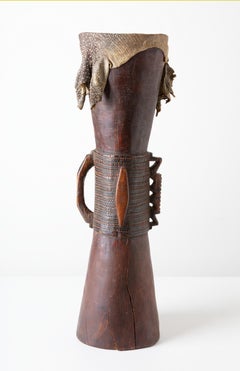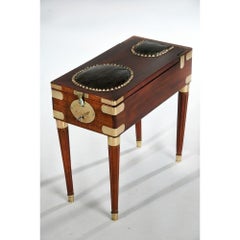Mahogany More Art
to
1
1
1
1
Overall Width
to
Overall Height
to
3
1
3
1
20,867
7,094
4,068
3,375
2,892
4
Medium: Mahogany
'Drum Ceremonial' Wood (Mahogany), Lizard skin
Located in Milwaukee, WI
New Guinea, Ceremonial Drum, Wood (Mahogany), Lizard skin
24 1/2 x 7"d.
Category
20th Century Mahogany More Art
Materials
Wood, Mahogany
Two Vintage Brass IN and OUT Signs
Located in Edgartown, MA
These charming vintage "IN" and "OUT" signs, hailing from England in the 20th century, offer a distinctive and functional touch to any collection or interior. Crafted in brass, they ...
Category
20th Century Mahogany More Art
Materials
Brass
Antique Three-Armed Brass Tall Table Lamp
Located in Edgartown, MA
Three-Armed Brass Table Lamp, is in very good overall condition. Circa 1900, combining classic craftsmanship with timeless appeal. Wooden base adds warmth and character, highlightin...
Category
Early 20th Century Mahogany More Art
Materials
Brass
Fishmongers
Located in Dallas, TX
Fishmongers I. Oil /mahogany wood.
Oaxaca, Mexico.
Category
21st Century and Contemporary Mahogany More Art
Materials
Mahogany
$2,500
Related Items
Close to Heart 1 & 2 - Wood sculpture by Zlata Kornilova
Located in Paris, FR
Sculpture Close to Heart 1 & 2
Limited edition of 12 (each sculpture)
Dimensions:
- Close to heart 1 (black): H. 73. x D. 34 cm
- Close to heart 2 (natural): H. 82. x D. 22 cm
Medi...
Category
21st Century and Contemporary Abstract Mahogany More Art
Materials
Steel
$6,112
H 28.75 in Dm 13.39 in
JEAN-MICHEL BASQUIAT - Charles The First. Skate Decks Pop Urban Art Design
Located in Madrid, Madrid
Jean-Michel Basquiat - Charles The First
Date of creation: 2024
Medium: Digital print on Canadian maple wood
Edition: Open
Size: 80 x 20 cm (each skate)
Condition: In mint conditions and never displayed
This triptych is formed by three skate decks made of 7 ply grade A Canadian maple wood.
© Estate of Jean-Michel Basquiat. Licensed by Artestar, New York
This skateboard set reproduces Charles The First (1982), a key work by Jean-Michel Basquiat that pays tribute to Charlie Parker, the influential jazz saxophonist known as "Bird." Basquiat captures the frantic energy and complexity of Parker through his signature style, blending elements of Black culture, music, and the figure of the artist in a raw and powerful representation.
The original painting, executed with acrylics, oils, and pastels, presents a stylized figure that recalls both a portrait and a symbol. The face is fragmented, filled with quick strokes and vibrant colors, while the outline and details evoke both divinity and struggle. Basquiat uses his unique visual language to convey the chaos and beauty of Parker’s life, a metaphor for creativity as a form of resistance and expression.
Transposed onto the skateboard format, Charles The First becomes a dynamic work of art that not only celebrates the life of a musical icon but also merges contemporary art with urban culture. This piece transcends simple reproduction, inviting a connection between visual art and movement in the streets, with the same vigor and attitude Basquiat infused into his work.
ABOUT THE ARTIST
Jean-Michel Basquiat (1960-1988) was one of the most influential artists of the 20th century, famous for his ability to fuse urban culture, social criticism and art history into a unique style. Born in Brooklyn, New York, to a Haitian father and Puerto Rican mother, his life and work were shaped by his multicultural heritage, the New York art scene and the social tensions of his time. Although his career was brief, his impact on contemporary art has been lasting and significant.
Basquiat showed an interest in art from an early age. His mother, Matilde Andrades, took him to museums and encouraged him to draw. At the age of seven, a car accident left him hospitalized for a time, and it was then that his mother gave him a copy of the anatomy book Gray's Anatomy, which influenced his fascination with the human body and its visual representation.
Despite his early talent, Basquiat's family life was turbulent. His mother was hospitalized for psychiatric problems and his relationship with his father, Gerard Basquiat, was troubled. This instability contributed to Basquiat dropping out of school at age 17 to pursue his artistic career on the streets of New York.
As a teenager, Basquiat joined the New York graffiti scene under the pseudonym SAMO (an acronym for "Same Old Shit"), which he used to sign his cryptic and poetic messages on the streets of Manhattan with his friend Al Diaz. SAMO's graffiti were a mixture of philosophical and social commentary on popular culture, capitalism and religion, and soon attracted the attention of the underground art scene.
In 1980, SAMO "died" when Basquiat and Diaz decided to end their collaboration, marking the beginning of Basquiat's transition from street graffiti to art galleries.
Basquiat emerged as a talent to watch in 1980, when he participated in the group exhibition The Times Square Show, which included other emerging artists from New York's Lower East Side scene. That same year, he attracted the attention of critics and collectors who saw in his work an electrifying blend of street art and neo-expressionism, the predominant movement of the time.
In 1981, art critic René Ricard published the influential essay The Radiant Child in Artforum magazine, which positioned Basquiat as one of the most promising artists of his generation. Shortly thereafter, he met renowned artist Andy Warhol, with whom he formed a close friendship and significant artistic collaboration. This association was instrumental in catapulting his career into the world of high art.
The collaboration with Warhol was a pivotal point in Basquiat's career. The two artists, although coming from very different worlds, shared a fascination with fame and popular culture. Together, they produced a series of works that combined Warhol's pop art icons with Basquiat's raw, spontaneous style.
However, this collaboration was also a source of controversy. Many critics accused Warhol of "exploiting" Basquiat, while others saw the collaboration as a creative dialogue between two genius minds. Although the criticism was mixed, there is no doubt that the relationship between the two artists helped cement Basquiat's reputation in the art world.
Basquiat's style is a unique amalgam of influences. His work is characterized by the use of dismembered human figures, skeletons and internal organs, evoking the fragility of the body and mortality. Basquiat also used symbols that alluded to African-American and African history, such as crowns, masks and references to historical figures such as Toussaint Louverture.
The use of text is another crucial aspect of his work. Words, phrases and numbers appeared in his paintings, often crossed out or overlapped, creating a sense of controlled chaos. These fragmented words provoked a non-linear reading of his works and conveyed multiple layers of meaning.
His art also reflected his concerns about racial issues, especially the place of people of African descent in Western art history and in society at large. The crowns that Basquiat often drew on his figures were a symbol of power and resistance, a way of proclaiming himself "king" in a world that had historically excluded black artists from the upper echelons of art.
In works such as The Death of Michael Stewart...
Category
2010s Pop Art Mahogany More Art
Materials
Wood, Digital
$1,003
H 31.5 in W 23.63 in D 0.79 in
EDWARD HOPPER - Early Sunday Morning. Skate Deck American Art Design
By Edward Hopper
Located in Madrid, Madrid
Edward Hopper - Early Sunday Morning
Date of creation: 2022
Medium: Digital print on Canadian maple wood
Edition: Open
Size: 80 x 20 cm
Condition: In mint conditions and never displ...
Category
2010s Pop Art Mahogany More Art
Materials
Wood, Digital
$352
H 31.5 in W 7.88 in D 0.79 in
EDWARD HOPPER - CITY ROOFS Skate Deck Modern Design Pop
By Edward Hopper
Located in Madrid, Madrid
EDWARD HOPPER - CITY ROOFS
Date of creation: 2022
Medium: Digital print on Canadian maple wood
Edition: Open
Size: 80 x 20 cm (each skate)
Condition: In mint conditions and never d...
Category
2010s Expressionist Mahogany More Art
Materials
Wood, Maple, Screen
Antique, 19th C. Peugeot Frères Brevetés French Coffee Grinder Table Sculpture
Located in Surfside, FL
This is being sold as a piece of (functional?) decorator table sculpture for a kitchen or restaurant. I do not know if or how it works. the wheel and gears turn. It might be missing a cover on the handle. It is a lovely antique piece. Made in France.
A halfcentury before they produced their first car, the Peugeot brothers were making coffee grinders, continuing to do so for over 100years. In 1840 the Peugeots produced their first moulin a
cafe out of a combination of metal and wood. The beans were inserted into the metal
hopper up top; metal gears were turned by a woodenknob-capped metal...
Category
Late 19th Century Modern Mahogany More Art
Materials
Metal, Brass
$850
H 14.5 in W 14 in D 8.5 in
Erhard & Söhne Art Nouveau Jugendstil Jewelry Casque w/ Inlaid Brass Rose Design
Located in Beachwood, OH
Erhard & Söhne, 19th Century
Art Nouveau Jugendstil Casque with Inlaid Brass Rose Design, c. 1904
6 x 9 x 6 inches
The company Erhard & sons was established by Carl Gottlieb Erhard ...
Category
Early 1900s Mahogany More Art
Materials
Brass
$3,500
H 6 in W 9 in D 6 in
ROY LICHTENSTEIN - EXPLOSION, 1967. Skate Decks Pop Art Design Modern
Located in Madrid, Madrid
Roy Lichtenstein - Explosion, 1967
Date of creation: 2024
Medium: Digital print on Canadian maple wood
Edition: Open
Size: 80 x 20 cm (each skate)
Condition: In mint conditions and ...
Category
2010s Pop Art Mahogany More Art
Materials
Wood, Digital
$1,003
H 31.5 in W 23.63 in D 0.79 in
Peacock Brass and Agate Sculpture on Black Marble Base Attributed to Willy Daro
Located in Clermont-Ferrand, Auvergne-Rhône-Alpes
This amazing sculpture figures a peacock making the wheel. Each feather is made of a slice of transparent agate, soldered with brass to the rest of the wheel. The agate wheel is me...
Category
1970s Other Art Style Mahogany More Art
Materials
Marble, Brass
$5,664
H 16.15 in W 17.92 in D 7.88 in
Yasu - Burnt Wood sculpture by Zlata Kornilova
Located in Paris, FR
Sculpture YASU
Limited edition of 12
Mediums: burnt wood and brass
Discover the stunning artistry of Zlata Kornilova with this exquisite sculpture crafted from burnt wood using the...
Category
21st Century and Contemporary Abstract Mahogany More Art
Materials
Steel
$3,056
H 36.62 in Dm 9.85 in
Close to Heart 2 - Wood sculpture by Zlata Kornilova
Located in Paris, FR
Sculpture Close to Heart 2
Limited edition of 12
Mediums: old pine, steel, acrylic hand painted, oil
CLOSE TO HEART - Collection
Working on the series I used a “wood with history”...
Category
21st Century and Contemporary Abstract Mahogany More Art
Materials
Steel
$3,056
H 32.29 in Dm 8.67 in
'Space Between' Wooden Sculpture by Camilo Andres Rodriguez Marquez
Located in Paris, FR
Space Between by Camilo Andres Rodriguez Marquez
Burnt Wood Sculpture
Dimensions: H. 54 x 19.5 x 10 cm
Camilo Andres Rodriguez Marquez is a Col...
Category
21st Century and Contemporary Contemporary Mahogany More Art
Materials
Wood
$1,040
H 21.26 in W 7.68 in D 3.94 in
JEAN-MICHEL BASQUIAT - In Italian. Skate Decks Pop Urban Art Design
Located in Madrid, Madrid
Jean-Michel Basquiat - In Italian
Date of creation: 2024
Medium: Digital print on Canadian maple wood
Edition: Open
Size: 80 x 20 cm (each skate)
Condition: In mint conditions and never displayed
This triptych is formed by three skate decks made of 7 ply grade A Canadian maple wood.
© Estate of Jean-Michel Basquiat. Licensed by Artestar, New York
In Italian (1983) is one of Jean-Michel Basquiat’s iconic works, created during a peak period of his artistic career. The piece reflects his distinctive style, blending graffiti, expressive brushwork, text, and symbolism. Like many of his paintings, "In Italian" presents a powerful and chaotic composition where words, figures, and signs interact in a raw and energetic visual language.
The title, In Italian, may suggest a reference to classical European culture—especially Italian Renaissance art—while at the same time subverting it through Basquiat’s urban, Afro-Caribbean perspective. His interest in contrasting high and low culture, refined and raw, is evident in this piece. The inclusion of text, often fragmented or cryptic, was one of Basquiat’s trademarks and serves here to provoke thought rather than deliver a clear message.
In this work, Basquiat explores themes such as identity, language, cultural heritage, and the appropriation of symbols. The figure depicted—alongside the textual elements—appears almost mythological or totemic, reinforcing Basquiat’s tendency to elevate marginalized characters into powerful, almost divine figures.
The brushstrokes are urgent, the colors bold, and the composition layered. It’s as if the viewer is meant to decipher a code—a mix of history, race, rebellion, and irony. Words in different languages, especially English and Italian, appear not to clarify meaning but to complicate it, suggesting the multilingual, multicultural environment Basquiat inhabited and commented on.
In Italian is a prime example of how Basquiat merged influences from the streets of New York with art history, African-American identity, and global culture. It's a bold visual statement that challenges traditional canons and forces the viewer to reconsider what art is, who gets to create it, and which voices are heard.
ABOUT THE ARTIST
Jean-Michel Basquiat (1960-1988) was one of the most influential artists of the 20th century, famous for his ability to fuse urban culture, social criticism and art history into a unique style. Born in Brooklyn, New York, to a Haitian father and Puerto Rican mother, his life and work were shaped by his multicultural heritage, the New York art scene and the social tensions of his time. Although his career was brief, his impact on contemporary art has been lasting and significant.
Basquiat showed an interest in art from an early age. His mother, Matilde Andrades, took him to museums and encouraged him to draw. At the age of seven, a car accident left him hospitalized for a time, and it was then that his mother gave him a copy of the anatomy book Gray's Anatomy, which influenced his fascination with the human body and its visual representation.
Despite his early talent, Basquiat's family life was turbulent. His mother was hospitalized for psychiatric problems and his relationship with his father, Gerard Basquiat, was troubled. This instability contributed to Basquiat dropping out of school at age 17 to pursue his artistic career on the streets of New York.
As a teenager, Basquiat joined the New York graffiti scene under the pseudonym SAMO (an acronym for "Same Old Shit"), which he used to sign his cryptic and poetic messages on the streets of Manhattan with his friend Al Diaz. SAMO's graffiti were a mixture of philosophical and social commentary on popular culture, capitalism and religion, and soon attracted the attention of the underground art scene.
In 1980, SAMO "died" when Basquiat and Diaz decided to end their collaboration, marking the beginning of Basquiat's transition from street graffiti to art galleries.
Basquiat emerged as a talent to watch in 1980, when he participated in the group exhibition The Times Square Show, which included other emerging artists from New York's Lower East Side scene. That same year, he attracted the attention of critics and collectors who saw in his work an electrifying blend of street art and neo-expressionism, the predominant movement of the time.
In 1981, art critic René Ricard published the influential essay The Radiant Child in Artforum magazine, which positioned Basquiat as one of the most promising artists of his generation. Shortly thereafter, he met renowned artist Andy Warhol, with whom he formed a close friendship and significant artistic collaboration. This association was instrumental in catapulting his career into the world of high art.
The collaboration with Warhol was a pivotal point in Basquiat's career. The two artists, although coming from very different worlds, shared a fascination with fame and popular culture. Together, they produced a series of works that combined Warhol's pop art icons with Basquiat's raw, spontaneous style.
However, this collaboration was also a source of controversy. Many critics accused Warhol of "exploiting" Basquiat, while others saw the collaboration as a creative dialogue between two genius minds. Although the criticism was mixed, there is no doubt that the relationship between the two artists helped cement Basquiat's reputation in the art world.
Basquiat's style is a unique amalgam of influences. His work is characterized by the use of dismembered human figures, skeletons and internal organs, evoking the fragility of the body and mortality. Basquiat also used symbols that alluded to African-American and African history, such as crowns, masks and references to historical figures such as Toussaint Louverture.
The use of text is another crucial aspect of his work. Words, phrases and numbers appeared in his paintings, often crossed out or overlapped, creating a sense of controlled chaos. These fragmented words provoked a non-linear reading of his works and conveyed multiple layers of meaning.
His art also reflected his concerns about racial issues, especially the place of people of African descent in Western art history and in society at large. The crowns that Basquiat often drew on his figures were a symbol of power and resistance, a way of proclaiming himself "king" in a world that had historically excluded black artists from the upper echelons of art.
In works such as The Death of Michael Stewart...
Category
2010s Pop Art Mahogany More Art
Materials
Wood, Digital
$1,003
H 31.5 in W 23.63 in D 0.79 in
Previously Available Items
Small Cabinet Of Ease Signed De Biennais
Located in ROUEN, FR
"Small Cabinet Of Ease Signed De Biennais"
SMALL CABINET D'AISANCE said to travel in solid mahogany with a top revealing a silver metal basin. Signed by BIENNAIS au Singe Violet, rue St HONORE...
Category
18th Century Mahogany More Art
Materials
Mahogany
Mahogany more art for sale on 1stDibs.
Find a wide variety of authentic Mahogany more art available on 1stDibs. While artists have worked in this medium across a range of time periods, art made with this material during the 20th Century is especially popular. There are many well-known artists whose body of work includes ceramic sculptures. Not every interior allows for large Mahogany more art, so small editions measuring 0.1 inches across are also available Prices for more art made by famous or emerging artists can differ depending on medium, time period and other attributes. On 1stDibs, the price for these items starts at $1 and tops out at $929,058, while the average work can sell for $1,099.
Recently Viewed
View AllMore Ways To Browse
Gilbert Magu Lujan
Glacier National Park Paintings
Gone Fishing Vintage
Gordon Setter
Graham Boyd
Grapevine Oil Painting
Great Dane Painting
Greek Artists Painting
Grouse Shooting
Harry Adams
Harry Day Paintings
Harvey Parks
Hedge House
Henry Collins
Hermes Birkin Bag 15
Highland Cow Painting
Hippo Painting
Hoppe Oil




